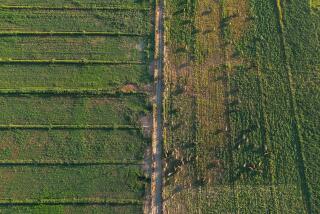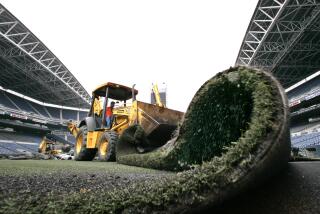Seeds of Ecology : Water-Absorbing Chemical May Be Boon to Landscaping, but Unconvinced Critics Call It Drought-Induced Hype
Its proponents are calling it the wonder drug of landscaping.
All Southern California residents need to do, they say, is add something called polyacrylamide to their landscaping and it will keep yards lush and green for years while using up to 60% less water.
In an era of water rationing, the potential appeal is enormous. Even its proponents say it seems too good to be true.
But critics who challenge its effectiveness are calling it a case of drought-induced hype.
Mostly confined to behind-the-scenes uses, the water absorbing chemical recently has become much more widely known. From Los Angeles County’s high desert to the shores of San Diego, vendors have convinced many public agencies to give it a try.
The results have been decidedly mixed.
The Rose Bowl in Pasadena quietly used it two years ago and ended up with turf so wet it had to be removed. Caltrans says it has helped keep freeway trees alive but in some cases pushed plants out of the ground. Officials at UCLA, however, say it’s been a water-saver for their baseball and soccer fields.
Los Angeles city parks officials are planning their first test at a Woodland Hills park later this year. San Diego city parks officials also are about to begin a major test. And Lancaster is considering requiring it for most of that city’s new landscaping.
The next selling wave, however, promises to be aimed at homeowners, an unproven but vast test ground. In the past, there was no practical way to use the chemical on established lawns. It had to be tilled into the ground before planting. But new injection machines might breach that barrier.
“People are just going nutso over this little product, and rightly so, because it works,” said Mike McWilliams, the owner of an Antelope Valley hydroseeding company. After convincing city officials in Palmdale, he was paid last week to inject the chemical into areas of the city’s golf course.
Enthusiasm for polyacrylamide is hardly unanimous, however. Some turf experts say the injection machines can harm lawns by severing roots. Others say claims of water savings appear unproven and wildly exaggerated. And the cost can range from hundreds to thousands of dollars for a typical yard.
“My feeling is they’re not useful,” said Jim Downer, a state researcher based in Ventura who complained that too many articles on the substance have read like ads. “We can save water and do so much more with mundane conventional things. But people want miracles. That’s why they’re so popular.”
Whether polyacrylamide works or not, the small granules that look like rock salt are intriguing to watch. Part of a broad group of chemicals called polymers, they rapidly swell into marble-sized balls of a gel-like material by absorbing and holding water.
At a recent community meeting in Palmdale, McWilliams displayed one tiny plastic bag containing about a teaspoon of the granules alongside a larger freezer-type bag filled with the gel material, the result of adding water.
Mixed with soil before planting or injected several inches underground afterward, the granules can hold up to 400 times their weight in water, gradually releasing it to the roots of plants. In that way, grass, shrubs and trees need less irrigation, saving both water and money for their users, proponents say. The substance, described as resistant to both heat and freezing, can repeatedly absorb and release water over periods from five to 10 years, according to claims.
“This has everything going for it. It makes things grow better and faster. I’ve never been involved in something that does so much good,” said Bob Burdick, a spokesman for San Diego-based Broadleaf Industries Inc., which sells a polyacrylamide product called Broadleaf P4.
Other polyacrylamide or similar polymer-based brands include Drought Busters, Agrosoke, Hydrosource, Water Crystals and Terra-Sorb, according to state records. Store prices run about $10 to $12 a pound. Suggested application rates range from five to 40 pounds per 1,000 square feet.
But a chief complaint by critics is that polyacrylamide appears to lose much of its water-holding capacity when exposed to salts and minerals commonly found in municipal water, California soils and even fertilizers. And, they argue that product claims and water savings have not been independently verified.
Downer, a landscape specialist with the University of California Cooperative Extension, said a test he conducted on grass last year showed no benefit. And Richard Evans, a researcher at UC Davis, said his research with potted plants also showed no advantage.
“I have not seen any research that touts them as being all that wonderful in water saving,” said Evans, who once was threatened with a lawsuit by a Broadleaf official because of his criticism. He suggested homeowners ask vendors for free samples to decide the issue in their own yards.
While disputing the quality of the testing, C. Dean Piper, Broadleaf’s chief research official, conceded that minerals make the chemical less effective and that he wouldn’t use the current injecting machines on his lawn. But he insisted that the chemical works and says better machines are forthcoming.
Even proponents agreed that the chemical has not been without its hype. And new sellers of the product are popping up all the time. In Palmdale, before the city officials went with McWilliams’ firm, Sand Castle Hydroseeding, another firm persuaded them to let it treat part of the city’s Desert Aire Golf Course for free. Months later, the treatment has proven useless and city officials say the vendor has vanished. Nonetheless, city officials facing possible future water restrictions are willing to try the product again.
“There is a lot of snake oil out there,” said Rich Ohara, the grounds manager who oversees UCLA’s vast expanse of landscaping. Ohara, who may expand the use of the chemical, successfully injected it into several turf areas nearly a year ago.
At the Rose Bowl, General Manager Greg Asbury said he decided to test the product on the west sideline before adding new turf in the spring of 1989. Despite the result, Asbury said the removed soil has worked well for landscaping nearby.
At Caltrans, landscape specialist Jack Thompson said the chemical, which the agency has used at about a half dozen sites in Los Angeles County, has helped increased the survival rate of new trees. But in one case, the granules swelled so much with water that they pushed plants out of the ground.
In Beverly Hills, city officials said they have used the chemical to save water on flower beds in the median of Rodeo Drive and plan to add it at Will Rogers Park this week.
But at Los Angeles International Airport, officials said one brand of the product hasn’t worked well, so they’re looking for another.
Although it is manufactured mostly abroad from a related chemical called acrylamide, which the federal Environmental Protection Agency considers a suspected carcinogen, U.S.-based distributors of polyacrylamide insist it is safe, and EPA officials do not dispute their claim.
After years in the soil, the chemical eventually breaks down into carbon dioxide, water and other materials along with a tiny amount of acrylamide. Although that concerns some environmentalists, vendors insist it rapidly dissipates and the state has approved the product for use.
“There’s a lot of variation associated with how effective these materials can be. The environment you place them in has a lot to do with it,” said Steve Wong, an official with the state Department of Food and Agriculture. It has licensed about a dozen distributors for such products since 1988.
Apart from a few tests that have drawn mixed results, probably least known about polyacrylamide is how well it works once injected into existing lawns.
Those who have used it are more optimistic about applying it before planting.
For example, Mike Campbell, Lancaster parks superintendent, said he believes in the chemical enough to recommend that the city require it for most new landscaping. But he warned that injecting it into existing lawns could stop them from developing deep, water-drawing roots.
Los Angeles parks officials plan to add the chemical as a pre-planting material when they refurbish Serrania Avenue Park in Woodland Hills later this year.
Water Savers
The drought has spurred a growing campaign promoting the use of a chemical polymer called polyacrylamide that suppliers claim can reduce the need for watering of residential or other landscaping by up to 60%. But its merit is being debated, and some researchers say the claims are exaggerated and unproven.
Sowing Polymers
The product starts out as small granules resembling rock salt. It can be tilled into the ground before planting or injected under existing landscape using new machines. Suppliers are pitching the product to homeowners as a way to maintain lush grass and shrubs in an era of water-use restrictions.
Absorbency
Once in the soil and watered, the chemical supposedly can absorb and retain up to several hundred times its weight in water, and turns into a gel material that nurtures plant roots. Suppliers say one application of the chemical, mostly used by nurseries, can remain effective for years.
The Debate
But some researchers who have studied polyacrylamide contend that salts and minerals in water supplies and the soil can drastically reduce its effectiveness. They argue its use on lawns can be counterproductive. And it can cost the typical homeowner hundreds of dollars to apply.
More to Read
Sign up for Essential California
The most important California stories and recommendations in your inbox every morning.
You may occasionally receive promotional content from the Los Angeles Times.










